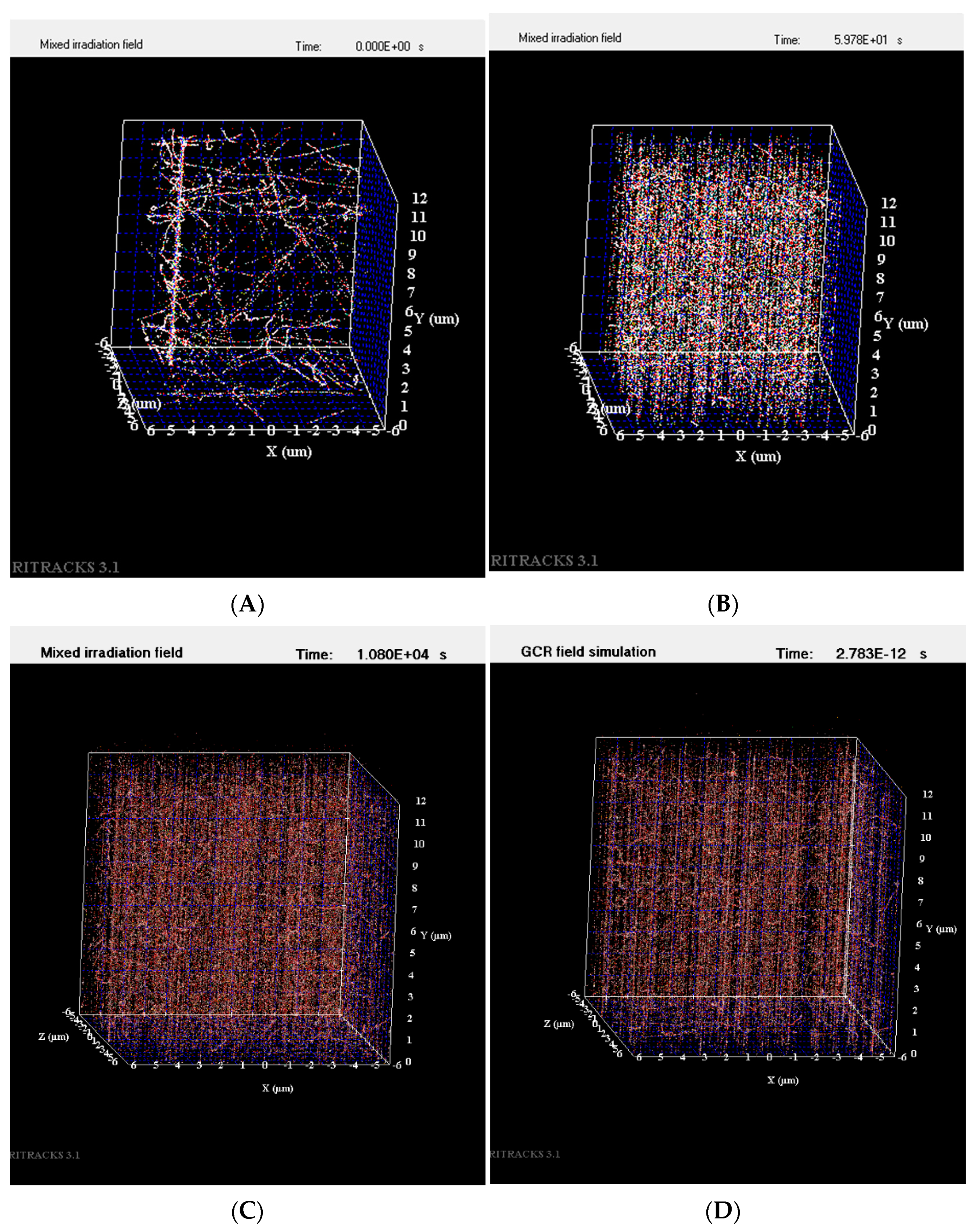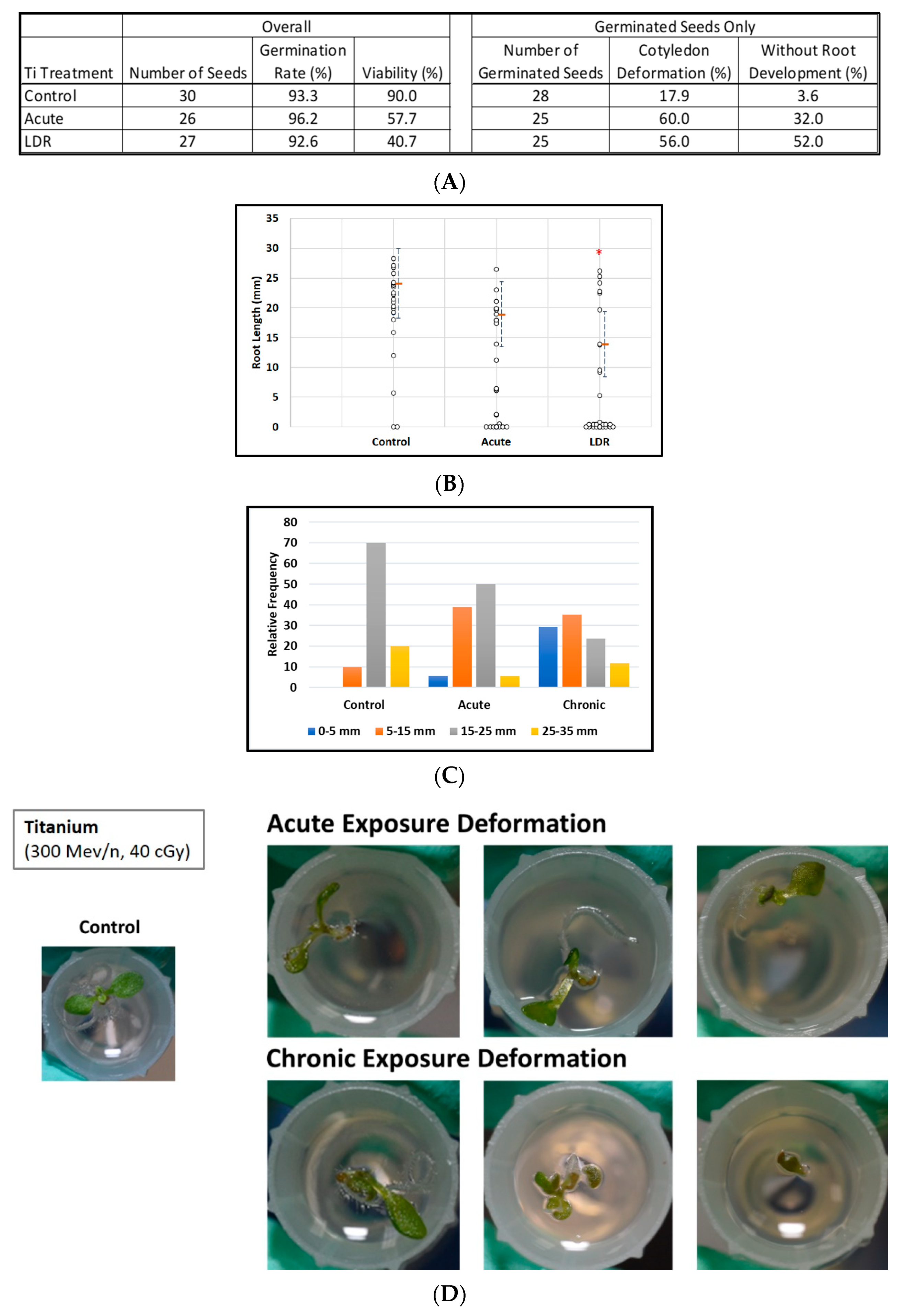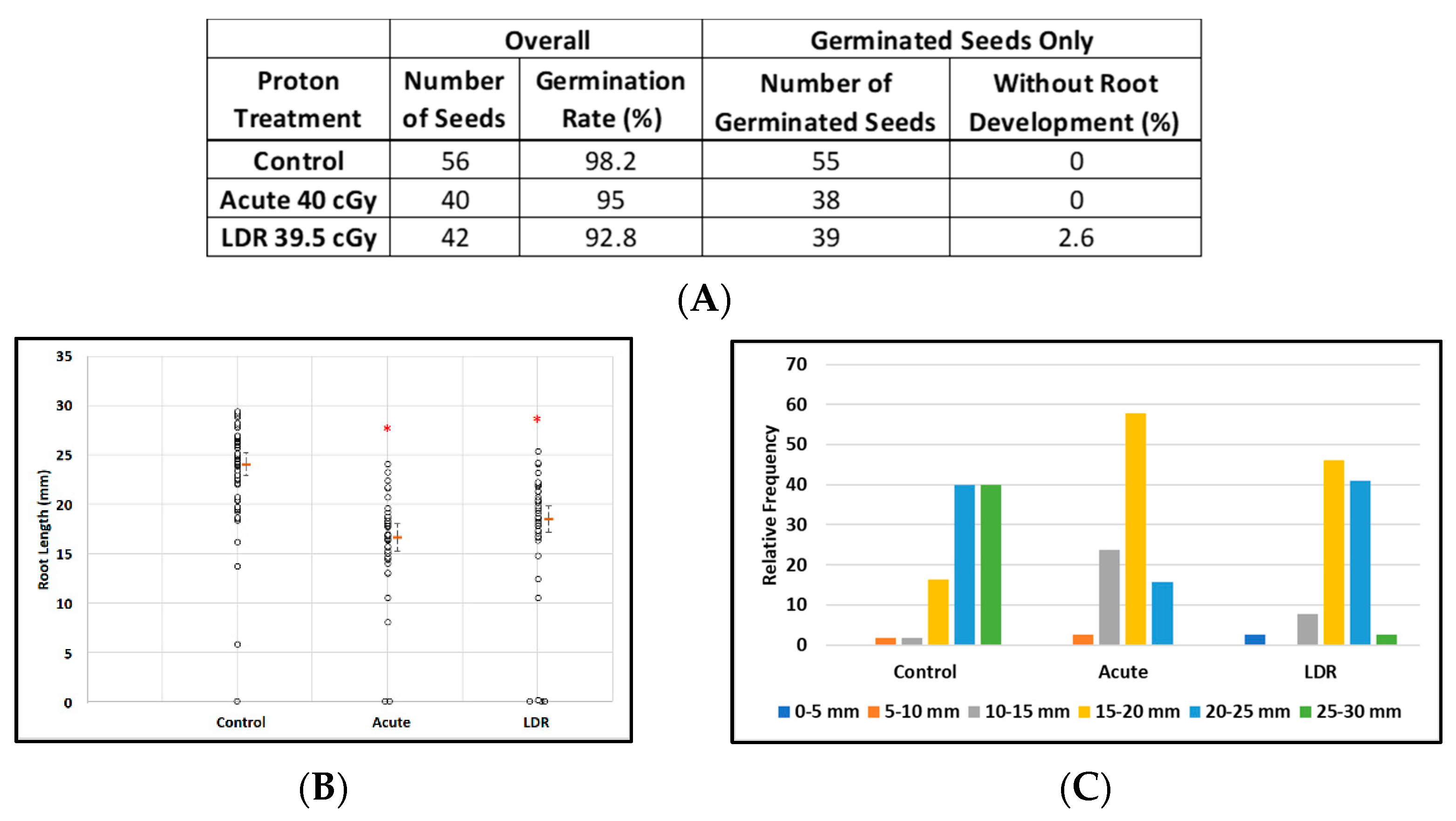Response of Arabidopsis thaliana and Mizuna Mustard Seeds to Simulated Space Radiation Exposures
Abstract
:1. Introduction
2. Materials and Methods
2.1. Plants
2.2. Radiation Scenarios
2.3. Preparation of Seeds for Irradiation and Growth Study
2.4. Mathematical Simulation and Radiation Track Analysis
2.5. Statistical Analysis
3. Results
3.1. Effect of Titanium Ion and Proton Exposure on Imbibed Arabidopsis Seeds
3.2. Effect of GCR-1 Scenario on Imbibed Arabidopsis Seeds
3.3. Effect of GCR2 on Dry Arabidopsis and Mizuna Seeds
3.4. Effect of SPE on Imbibed Arabidopsis and Mizuna
4. Discussion
4.1. Charged Particle Exposure and Hydrated Arabidopsis Seeds
4.2. Space Mission Relevant Experiments
4.3. Comparison with Other Studies
5. Conclusions and Future Work
Author Contributions
Funding
Institutional Review Board Statement
Informed Consent Statement
Data Availability Statement
Acknowledgments
Conflicts of Interest
References
- Cooper, M.; Perchonok, M.; Douglas, G.L. Initial assessment of the nutritional quality of the space food system over three years of ambient storage. NPJ Microgravity 2017, 3, 17. [Google Scholar] [CrossRef]
- Catauro, P.M.; Perchonok, M.H. Assessment of the Long-Term Stability of Retort Pouch Foods to Support Extended Duration Spaceflight. J. Food Sci. 2012, 77, S29–S39. [Google Scholar] [CrossRef]
- Odeh, R.; Guy, C.L. Gardening for therapeutic people-plant interactions during long-duration space missions. Open Agric. 2017, 2, 1–13. [Google Scholar] [CrossRef]
- Cucinotta, F.A.; Durante, M. Cancer risk from exposure to galactic cosmic rays: Implications for space exploration by human beings. Lancet Oncol. 2006, 7, 431–435. [Google Scholar] [CrossRef] [Green Version]
- Dartnell, L.R. Ionizing radiation and life. Astrobiology 2011, 11, 551–582. [Google Scholar] [CrossRef] [Green Version]
- Huff, J.; Carnell, L.S.; Blattnig, S.; Chappell, L.; Kerry, G.; Lumpkins, S.; Simonsen, L.; Slaba, T.S.; Werneth, C. Evidence Report: Risk of Radiation Carcinogenesis. In NASA Technical Publication; 2016; TP20160004369. Available online: https://ntrs.nasa.gov/citations/20160004369 (accessed on 14 January 2022).
- Zeitlin, C.; Hassler, D.M.; Cucinotta, F.A.; Ehresmann, B.; Wimmer-Schweingruber, R.F.; Brinza, D.E.; Kang, S.; Weigle, G.; Böttcher, S.; Böhm, E.; et al. Measurements of Energetic Particle Radiation in Transit to Mars on the Mars Science Laboratory. Science 2013, 340, 1080–1084. [Google Scholar] [CrossRef] [Green Version]
- Hassler, D.M.; Zeitlin, C.; Wimmer-Schweingruber, R.F.; Ehresmann, B.; Rafkin, S.; Eigenbrode, J.L.; Brinza, D.E.; Weigle, G.; Böttcher, S.; Böhm, E.; et al. Mars’ Surface Radiation Environment Measured with the Mars Science Laboratory’s Curiosity Rover. Science 2014, 343, 1244797. [Google Scholar] [CrossRef] [Green Version]
- Arena, C.; De Micco, V.; Macaeva, E.; Quintens, R. Space radiation effects on plant and mammalian cells. Acta Astronaut. 2014, 104, 419–431. [Google Scholar] [CrossRef]
- Donà, M.; Scheid, O.M. DNA Damage Repair in the Context of Plant Chromatin. Plant. Physiol. 2015, 168, 1206–1218. [Google Scholar] [CrossRef] [Green Version]
- De Micco, V.; Arena, C.; Pignalosa, D.; Durante, M. Effects of sparsely and densely ionizing radiation on plants. Radiat. Environ. Biophys. 2011, 50, 1–19. [Google Scholar] [CrossRef]
- Hammond, E.C.; Bridgers, K.; Berry, F.D. Germination, growth rates, and electron microscope analysis of tomato seeds flown on the LDEF. Radiat. Meas 1996, 26, 851–861. [Google Scholar] [CrossRef] [Green Version]
- Nevzgodina, L.V.; Maximova, E.N.; Akatov, Y.A. Effects of prolonged exposure to space flight factors for 175 days on lettuce seeds. Adv. Space Res. 1981, 1, 83–85. [Google Scholar] [CrossRef]
- Grigoriev, Y.G.; Planel, H.; Delpoux, M.; Gaubin-Blanquet, Y.; Nevzgodina, L.V.; Pianezzi, B.; Popov, V.I.; Marenny, A.M.; Vinogradov, Y.A.; Pfhol, R.; et al. Radiobiological investigations in Cosmos 782 space flight (Biobloc SF1 experiment). Life Sci. Space Res. 1978, 16, 137–142. [Google Scholar] [PubMed]
- Simonsen, L.C.; Slaba, T.C.; Guida, P.; Rusek, A. NASA’s first ground-based Galactic Cosmic Ray Simulator: Enabling a new era in space radiobiology research. PLoS Biol. 2020, 18, e3000669. [Google Scholar] [CrossRef] [PubMed]
- Barker, R.; Lombardino, J.; Rasmussen, K.; Gilroy, S. Test of Arabidopsis Space Transcriptome: A Discovery Environment to Explore Multiple Plant Biology Spaceflight Experiments. Front. Plant. Sci. 2020, 11, 147. [Google Scholar] [CrossRef]
- Stutte, G.W.; Monje, O.; Yorio, N.C.; Edney, S.L.; Newsham, G.; Connole, L.; Wheeler, R.M. Sustained salad crop production requirements for lunar surface. SAE Int. J. of Aerosp. 2009, 4, 172–178. [Google Scholar] [CrossRef]
- Stutte, G.W.; Newsham, G.; Morrow, R.C.; Wheeler, R.M. Concept for Sustained Plant Production on ISS Using VEGGIE Capillary Mat Rooting System. In Paper 2011-5263; AIAA Tech: Reston, VA, USA, 2011. [Google Scholar]
- Massa, G.D.; Wheeler, R.M.; Stutte, G.W.; Richards, J.T.; Spencer, L.E.; Hummerick, M.E.; Douglas, G.L.; Sirmons, T. Selection of Leafy Green Vegetable Varieties for a Pick-and-Eat Diet Supplement on ISS. In Proceedings of the International Conference on Environmental systems. In NASA Technical Publication; 2015; TP20150018899. Available online: https://ntrs.nasa.gov/citations/20150018899 (accessed on 14 January 2022).
- Massa, G.D.; Newsham, G.; Hummerick, M.E.; Caro, J.L.; Stutte, G.W.; Morrow, R.C.; Wheeler, R.M. Preliminary species and media selection for the Veggie space hardware. Gravit. Space Res. 2013, 1, 95–106. [Google Scholar]
- Slaba, T.C.; Plante, I.; Ponomarev, A.; Patelb, Z.S.; Hada, M. Determination of Chromosome Aberrations in Human Fibroblasts Irradiated by Mixed Fields Generated with Shielding. Radiat. Res. 2020, 194, 246–258. [Google Scholar] [CrossRef] [PubMed]
- Norbury, J.W.; Schimmerling, W.; Slaba, T.C.; Azzam, E.I.; Badavi, F.F.; Baiocco, G.; Zeitlin, C.J.; Benton, E.; Bindi, V.; Blakely, E.A.; et al. Galactic cosmic ray simulation at the NASA Space Radiation Laboratory. Life Sci. Space Res. 2016, 8, 38–51. [Google Scholar] [CrossRef] [PubMed] [Green Version]
- Tessa, C.L.; Sivertz, M.; Chiang, I.; Lowenstein, D.; Rusek, A. Overview of the NASA space radiation laboratory. Life Sci. Space Res. 2016, 11, 18–23. [Google Scholar] [CrossRef] [PubMed] [Green Version]
- Massa, G.D.; Dufour, N.F.; Carver, J.A.; Hummerick, M.E.; Wheeler, R.M.; Morrow, R.C.; Smith, T.M. VEG-01: Veggie Hardware Validation Testing on the International Space Station. Open Agric. 2017, 2, 33–41. [Google Scholar] [CrossRef]
- Massa, G.D.; Newsham, G.; Hummerick, M.E.; Morrow, R.C.; Wheeler, R.M. Plant Pillow Preparation for the Veggie Plant Growth System on the International Space Station. Gravit. Space Res. 2017, 5, 24–34. [Google Scholar] [CrossRef]
- Plante, I.; Cucinotta, F.A. Monte-Carlo Simulation of Ionizing Radiation Tracks in Applications of Monte Carlo Methods in Biology, Medicine and Other Fields of Science; Mode, C.B., Ed.; InTech: London, UK, 2011; pp. 315–356. [Google Scholar]
- Turner, J.A. Radiation and Radiation Protection, 3rd ed.; Wiley: Hoboken, NJ, USA, 2007. [Google Scholar]
- Plante, I.; Poignant, F.; Slaba, T. Track Structure Components: Characterizing Energy Deposited in Spherical Cells from Direct and Peripheral HZE Ion Hits. Life 2021, 11, 1112. [Google Scholar] [CrossRef]
- Köhler, J.; Ehresmann, B.; Zeitlin, C.; Wimmer-Schweingruber, R.F.; Hassler, D.H.; Reitz, G.; Brinza, D.E.; Appel, J.; Bottcher, S.; Bohm, E.; et al. Measurements of the neutron spectrum in transit to Mars on the Mars Science Laboratory. Life Sci. Space Res. 2015, 5, 6–12. [Google Scholar] [CrossRef]
- Reitz, G.; Berger, T.; Matthiae, D. Radiation exposure in the moon environment. Planet. Space Sci. 2012, 74, 78–82. [Google Scholar] [CrossRef]
- Durante, M. Space radiobiology on the moon. Planet. Space Sci. 2012, 74, 72–77. [Google Scholar] [CrossRef]
- Cucinotta, F.A.; Kim, M.; Chappell, L.J. Space Radiation Cancer Risk Projections and Uncertainties. In NASA Technical Publication; 2010; TP20130001648. Available online: https://ntrs.nasa.gov/citations/20130001648 (accessed on 14 January 2022).
- Jurist, J. Human Factors in Commercial Suborbital Flight: Radiation Exposure and Weightlessness. The Space Review. 2005. Available online: http://www.thespacereview.com/article/464/1 (accessed on 13 January 2022).
- Copeland, K. Occupational Exposure to Ionizing Radiation for Crews of Suborbital Spacecraft: Questions & Answers. In Office of Aerospace Medicine; 2013; DOT/FAA/AM-13/23. Available online: https://rosap.ntl.bts.gov/view/dot/26809 (accessed on 14 January 2022).
- Benton, E. Space Radiation Passive Dosimetry. The Health Risks of Extraterrestrial Environments (THREE). 2012. Available online: https://three.jsc.nasa.gov (accessed on 14 January 2022).
- Möller, T. Measurement of the Radiation Exposure for High Altitude Flights in the Polar Region. Dissertation. Ph.D. Thesis, Christian-Albrechts-Universität, Kiel, Germany, 2013. Available online: https://macau.uni-kiel.de/servlets/MCRFileNodeServlet/dissertation_derivate_00005187/diss_tmoeller.pdf (accessed on 14 January 2022).
- Lisa, C.; Blattnig, S.; Hu, S.; Huff, J.; Kim, M.; Norman, R.; Patel, Z.; Simonsen, L.; Wu, H. Evidence Report: Risks of Acute Radiation Syndromes Due to Solar Particle Events. In NASA Technical Publication; 2016; TP20160003870. Available online: https://ntrs.nasa.gov/citations/20160003870 (accessed on 14 January 2022).
- Manova, V.; Gruszka, D. DNA damage and repair in plants—From models to crops. Front. Plant. Sci. 2015, 8, 885. [Google Scholar] [CrossRef] [Green Version]
- Bray, C.M.; West, C.E. DNA Repair Mechanisms in Plants: Crucial Sensors and Effectors for the Maintenance of Genome Integrity. New Phytologist 2005, 168, 511–528. [Google Scholar] [CrossRef]
- Nisa, M.; Huang, Y.; Benhamed, M.; Raynaud, C. The Plant DNA Damage Response: Signaling Pathways Leading to Growth Inhibition and Putative Role in Response to Stress Conditions. Front. Plant. Sci. 2019, 10, 653. [Google Scholar] [CrossRef] [PubMed] [Green Version]
- Kimura, S.; Tahira, Y.; Ishibashi, T.; Mori, Y.; Mori, T.; Hashimoto, J.; Sakaguchi, K. DNA repair in higher plants; photoreactivation is the major DNA repair pathway in non-proliferating cells while excision repair (nucleotide excision repair and base excision repair) is active in proliferating cells. Nucleic Acids Res. 2004, 32, 2760–2767. [Google Scholar] [CrossRef] [Green Version]
- Boyko, A.; Zemp, F.; Filkowski, J.; Kovalchuk, I. Double-strand break repair in plants is developmentally regulated. Plant. Physiol. 2006, 141, 488–497. [Google Scholar] [CrossRef] [PubMed] [Green Version]
- Novikova, N.; Deshevaya, E.; Levinskikh, M.; Polikarpov, N.; Poddubko, S.; Gusev, O.; Sychev, V. Study of the effects of the outer space environment on dormant forms of microorganisms, fungi and plants in the ‘Expose-R’ experiment. Int. J. Astrobiol. 2015, 14, 137–142. [Google Scholar] [CrossRef]
- Tepfer, D.; Leach, S. Survival and DNA Damage in Plant Seeds Exposed for 558 and 682 Days outside the International Space Station. Astrobiology 2017, 17, 205–215. [Google Scholar] [CrossRef] [Green Version]
- Califar, B.; Tucker, R.; Cromie, J.; Sng, N.; Schmitz, R.A.; Callaham, J.A.; Barbazuk, B.; Paul, A.; Ferl, R.J. Approaches for Surveying Cosmic Radiation Damage in Large Populations of Arabidopsis thaliana Seeds—Antarctic Balloons and Particle Beams. Gravit. Space Res. 2018, 6, 54–73. [Google Scholar] [CrossRef]
- Mousseau, T.A.; Møller, A.P. Plants in the Light of Ionizing Radiation: What Have We Learned from Chernobyl, Fukushima, and Other “Hot” Places? Front. Plant. Sci. 2020, 11, 552. [Google Scholar] [CrossRef] [PubMed]
- Mousseau, T.A. The Biology of Chernobyl. Annu. Rev. Ecol. Evol. Syst. 2021, 52, 87–109. [Google Scholar] [CrossRef]
- Caplin, N.; Willey, N. Ionizing Radiation, Higher Plants, and Radioprotection: From Acute High Doses to Chronic Low Doses. Front. Plant. Sci. 2018, 9, 847. [Google Scholar] [CrossRef] [PubMed]








| Model Organism | Scenario | Particle/s | Total Primary Dose Delivered (cGy) | Dose Rate (cGy/min) | Shielding | Total Dose Seeds Exposed (cGy) |
|---|---|---|---|---|---|---|
| Imbibed Arabidopsis seeds | Proton Particles | 250 MeV/n H1+ | 20 | Acute | N/A | 20 |
| 40 | Acute | N/A | 40 | |||
| 39.5 | 0.166 | N/A | 39.5 | |||
| Imbibed Arabidopsis seeds | Titanium Ions | 300 MeV/n Ti48+ | 20 | Acute | N/A | 20 |
| 40 | Acute | N/A | 40 | |||
| 39.5 | 0.166 | N/A | 39.5 | |||
| Imbibed Arabidopsis seeds | GCR1: Galactic cosmic ray (GCR) simulation | 44% 344 MeV/n H1+ 19% 344 MeV/n He4+ 24% 450 MeV/n O16+ 13% 950 MeV/n Fe56+ | 40 | Acute | 20 g/cm2 Aluminum and high density polyethylene 10.345 g/cm2 | 29 |
| 0.166 | ||||||
| 80 | Acute | 58 | ||||
| 0.166 | ||||||
| Dry Arabidopsis seeds and Mizuna seeds | GCR2: Simplified GCR simulation | 35% 1000 MeV/n H1+ 39% 250 MeV/n H1+ 18% 250 MeV/n He4+ 6% 350 MeV/n O16+ 1% 600 MeV/n Si+ 1% 600 MeV/n Fe56+ | 40 | Acute | N/A | 40 |
| 0.333 | ||||||
| 80 | Acute | 80 | ||||
| 0.333 | ||||||
| Imbibed Arabidopsis seeds and Mizuna seeds | SPE: 1972 simulation | 50–150 MeV/n H1+ | 40 | Acute | N/A | 40 |
| 0.444 | ||||||
| 80 | Acute | 80 | ||||
| 0.444 | ||||||
| 200 | Acute | 200 |
| Conditions | Mars Mission (Mars Science Lab) [6,7,23] | Lunar Mission (Apollo) [24,25] | On ISS * (~400 km) [29] | Sub-Orbital * (~120 km) [30,31] | Stratosphere above Antarctica * (30–37 km) [32,33] |
|---|---|---|---|---|---|
| Transit Journey | 1.84 ± 0.33 | 0.7–3 | ~0.5 (50–80% from GCR particles) | ~0.03–0.336 (Mercury 3) | 0.4–0.6 |
| Surface | 0.64 ± 0.12 (solar min) | 0.24–0.30 (solar max); 0.67–1.04 (Solar min) |
Publisher’s Note: MDPI stays neutral with regard to jurisdictional claims in published maps and institutional affiliations. |
© 2022 by the authors. Licensee MDPI, Basel, Switzerland. This article is an open access article distributed under the terms and conditions of the Creative Commons Attribution (CC BY) license (https://creativecommons.org/licenses/by/4.0/).
Share and Cite
Zhang, Y.; Richards, J.T.; Feiveson, A.H.; Richards, S.E.; Neelam, S.; Dreschel, T.W.; Plante, I.; Hada, M.; Wu, H.; Massa, G.D.; et al. Response of Arabidopsis thaliana and Mizuna Mustard Seeds to Simulated Space Radiation Exposures. Life 2022, 12, 144. https://doi.org/10.3390/life12020144
Zhang Y, Richards JT, Feiveson AH, Richards SE, Neelam S, Dreschel TW, Plante I, Hada M, Wu H, Massa GD, et al. Response of Arabidopsis thaliana and Mizuna Mustard Seeds to Simulated Space Radiation Exposures. Life. 2022; 12(2):144. https://doi.org/10.3390/life12020144
Chicago/Turabian StyleZhang, Ye, Jeffrey T. Richards, Alan H. Feiveson, Stephanie E. Richards, Srujana Neelam, Thomas W. Dreschel, Ianik Plante, Megumi Hada, Honglu Wu, Gioia D. Massa, and et al. 2022. "Response of Arabidopsis thaliana and Mizuna Mustard Seeds to Simulated Space Radiation Exposures" Life 12, no. 2: 144. https://doi.org/10.3390/life12020144
APA StyleZhang, Y., Richards, J. T., Feiveson, A. H., Richards, S. E., Neelam, S., Dreschel, T. W., Plante, I., Hada, M., Wu, H., Massa, G. D., Douglas, G. L., & Levine, H. G. (2022). Response of Arabidopsis thaliana and Mizuna Mustard Seeds to Simulated Space Radiation Exposures. Life, 12(2), 144. https://doi.org/10.3390/life12020144








